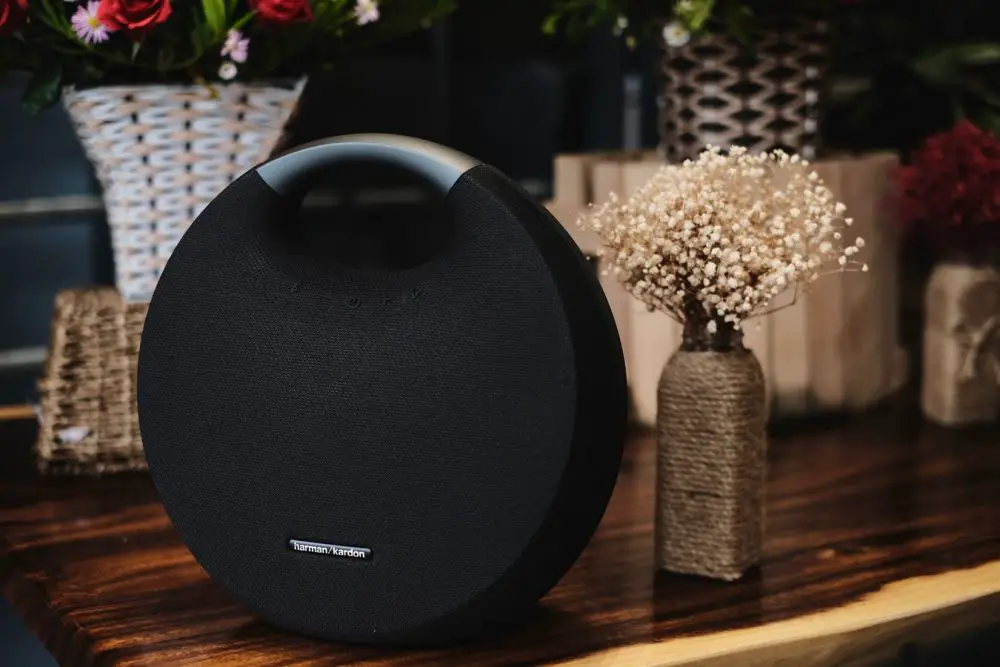When trying to narrow your options down, it’s good to single out a brand that you’re interested in. In this case, you’ve not only done that, but you also have your eye on a specific product line.
If you’re looking at the Onyx Studio line, it goes without saying that the Harman Kardon Onyx Studio 4 is the later and more technically impressive speaker than the Harman Kardon Onyx Studio 3.
This means you shouldn’t compare the two as if they were different products, and instead ask yourself which one is worth getting.

This makes the process much simpler since you only need to get the best speaker for your needs. You want the best, but sometimes the best model for you will be the humbler, more affordable option.
The best I can do is describe each product and let you decide which one you want. I’ve investigated and done exactly that below, so check out my review of each speaker and see what you think.
Harman Kardon Onyx Studio 3 vs Harman Kardon Onyx Studio 4
PRODUCT REVIEW
I’ll start with the Harman Kardon Onyx Studio 3, being the older of the two speakers. My review has been separated into different subheadings, so you can jump to what you think is most important when buying a speaker.
If you want to see my thoughts at a glance, I’ve got a pros and cons section for each speaker too.
Quality of Sound
For many of you, the most important quality that a speaker needs to have is its sound quality.
The Onyx Studio 3 is a popular speaker, so you can rest assured that many others have found the sound quality to be satisfactory.
Inside the speakers is a pair of tweeters and large woofers that support a deep and punchy bass.
Its frequency response range doesn’t support sub-bass sounds, but it hits bass as hard as most other wireless speakers on the market right now.
The bass is also clean, so it doesn’t boom when the speaker is playing pop or electronic dance music.
The mids that you get with the Onyx Studio 3 are just as fine as you’d expect, though that can be said for the Onyx Studio 4 too.
It’s common for Bluetooth speaker manufacturers to essentially sabotage the mids of their speakers since they don’t want to risk having an unpleasant sound performance, but I can say that this isn’t the case with the Harman Kardon Onyx Studio line.
This mid capability is great for subtler music styles like classical music or jazz. If the performance of the Onyx Studio 3 sags anywhere, it’s with the high-frequency sounds.
That’s not to say it’s poor, it’s absolutely fine, but the 3 can sound harsh if the music being played through it is full of high-frequency sounds.
Build and Design
Aside from the sound performance, most electronics should have a casing that’s both durable and appealing.
Unsurprisingly, the Harman Kardon Onyx Studio line is very similar in terms of their physical appearance.
They’re not colorful and they don’t try too hard to get your attention, opting for a sleek design that fits right in with other tech that’s found in the modern home.
The back of the Onyx Studio 3 is covered with black leather, which makes it one of the more elegant backsides of a speaker you can lay your eyes on.
The front is a much more pragmatic matte black instead that allows the speaker to blend into most rooms.
The Onyx Studio 3 is noticeably bulkier than the Onyx Studio 4, and it weighs 7.17 pounds.
This does improve the durability of the speaker since it has a more substantial frame that puts more material between any impact forces and the vulnerable electronics inside.
It should last you a good, long time so long as you’re not dropping it often.
Portability
As I said, the Onyx Studio 3 is heavier than the Onyx Studio 4, and this obviously has an effect on its portability.
The Onyx Studio line isn’t a small range of speakers, with the Onyx Studio 3 being 15” by 10” by 15”.
It’s also a saucer shape, which is handy and stylish for a Bluetooth speaker but makes it more awkward if you wanted to carry it around.
On the back, there’s a handle, but it’d be impractical to hold the speaker for prolonged periods of time.
These all mean you won’t be carrying this speaker around in your pocket, but you can carry them around in a bag so long as it won’t sustain any damage from anything else in the rucksack.
While I’m talking about portability, it should be said that the Onyx Studio 3 will get you around five hours of performance.
Compared to other speakers, this falls short of other models you can get, making this much more suited for domestic use than frequent portable use.
Control and Input
Your speaker will be useless if it doesn’t have the right input options, so it’s worth going through them.
There are three input ports on the Onyx Studio 3, those being the necessary power cord input, a 3.5mm input for aux purposes, and then a less-important micro-USB port that you’ll use to update the firmware that the speaker has.
You’d think you’d be able to use the USB port to make the speakers rechargeable or attach your handheld devices, but this functionality isn’t present.
It should be said that all of the above can be said for the Onyx Studio 4 too since these two speakers have the same inputs and only differ in their controls.
The Onyx Studio 3 features five buttons located on a control panel built into the speaker. On that panel, you’ll find its power button, two volume buttons, a speakerphone button, and a backlit Bluetooth button.
Pros and Cons
Pros:
- A decent speaker that can tackle bass sound.
- A sleek and modern design that’s simultaneously durable.
- Can be carried around if you have a bag.
- A minimal, easy to use control panel.
- A 3.5mm aux port for device connection.
Cons:
- May struggle with music that features a lot of high-frequency sounds.
- Bulkier than the Onyx Studio 4.
- Shorter battery life than other speakers.
PRODUCT REVIEW
As the later model, the Harman Kardon Onyx Studio 4 has additional features that the Onyx Studio 3 doesn’t, but the differences between them aren’t as obvious as you may expect.
Same deal as with the first half of this page, check out the subheadings below to see what the Onyx Studio 4 can offer you.
Quality of Sound
The difference in sound quality between the Onyx Studio 3 and the Onyx Studio 4 is quite slight but definitely noticeable depending on which music you’re going to be playing through the speaker.
Bass fans will find that the Studio 4 expands on the Studio 3’s bass performance, so you’ll probably want the Onyx Studio 4 if you’re going to be playing a lot of bass-heavy music.
If your music isn’t heavy on the bass, then only the most astute audiophiles will notice the slight difference in sound quality.
That said, the volume must be kept at a reasonable level otherwise the bass performance collapses into itself.
I’d advise you stick with 70 or 80 out of 100 volume since the bass will get distorted and sound quality will decrease.
The mids are identical to the Onyx Studio 3, so the Onyx Studio 4 should keep fans of jazz and classical music happy.
For highs, however, the Studio 4 handily beats the Studio 3. It has a wider soundstage than the Studio 3 that allows it to report all types of sound with high fidelity.
Build, Design and Portability
As I covered, the Onyx Studio line looks almost identical no matter which model you get. The Onyx Studio 4 has that same sleek, black design that the 3 has, so it’s compatible with most décor that’s found in the home.
The Onyx Studio 4 is technically heavier than the 3 at 7.20, but I’d say the 4 is the easiest to move because of its smaller size.
The Onyx Studio 4 is 13” by 12” by 8.5”, which are smaller dimensions than the 3 that make it the space-efficient option.
This smaller saucer shape makes it much easier to carry, though it’s still better to carry it in a rucksack over in your hand.
The Onyx Studio 4 also beats the 3 in battery life, lasting around eight hours. This is about three hours longer than the other Onyx Studio speaker, so this is the more appealing choice if longevity is important to you.
Control and Input
The Onyx Studio 4 has all the same inputs as the 3, those being a power socket, a 3.5mm aux, and a micro-USB to maintain the firmware that’s in the speaker.
The real difference is in the control panel, which has one extra button that the Onyx Studio 3 does not.
It has the same five buttons as the 3, the power button, volume buttons, hands-off speakerphone button, and the Bluetooth button, but it then has a new Connect+ button.
Pros and Cons
Pros:
- A well-rounded speaker that has improved bass performance.
- The same sleek and modern design as the Onyx Studio 3.
- Even more portable than the Onyx Studio 3.
- Runs Bluetooth 4.2, a later Bluetooth release.
- Superior battery life to the Onyx Studio 3.
Cons:
- The volume can’t be turned up too loud.
- The more expensive of the two speakers.
